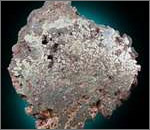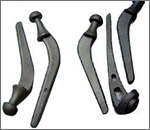Cobalt is a hard, lustrous, gray metal, a chemical element with symbol Co and atomic number 27. Although cobalt-based colors and pigments have been used since ancient times for

making jewelry and paints, and miners have long used the name kobold ore for some minerals, the free metallic cobalt was not prepared and discovered until 1735 by Georg Brandt.
Cobalt occurs in various metallic-lustered ores, for example cobaltite (CoAsS), but is mainly produced as a by-product of copper and nickel mining. The copper belt in the Democratic Republic of the Congo and Zambia yields most of the cobalt mined worldwide.
Cobalt is used in the preparation of magnetic, wear-resistant, and high-strength alloys. Smalte (cobalt silicate glass) and cobalt blue (cobalt(II) aluminate, CoAl2O4) gives a distinctive deep blue color to glass, ceramics, inks, paints, and varnishes. Cobalt-60 is a commercially important radioisotope, used as a tracer and in the production of gamma rays for industrial use.
Cobalt is an essential trace element for all multicellular organisms as the active center of coenzymes called cobalamins. These include vitamin B-12 which is essential for mammals. Cobalt is also an active nutrient for bacteria, algae, and fungi, and may be a necessary nutrient for all life.

Cobalt is a ferromagnetic metal with a specific gravity of 8.9 (20°C). Pure cobalt is not found in nature, but compounds of cobalt are common. Small amounts of it are found in mostrocks, soil, plants, and animals. It is the element of atomic number 27. The Curie temperature is 1115 °C, and the magnetic moment is 1.6–1.7 Bohr magnetons per atom. In nature, it is frequently associated with nickel, and both are characteristic minor components of meteoric iron.
Mammals require small amounts of cobalt which is the basis of vitamin B12. Cobalt-60, an artificially produced radioactive isotope of cobalt, is an important radioactive tracer and cancer-treatment agent. Cobalt has a relative permeability two thirds that of iron. Metallic cobalt occurs as two crystallographic structures: hcp and fcc. The ideal transition temperature between hcp and fcc structures is 450 °C, but in practice, the energy difference is so small that random intergrowth of the two is common.
Cobalt compounds have been used for centuries to impart a rich blue color to glass, glazes, and ceramics. Cobalt has been detected in Egyptian sculpture and Persian jewelry from the third millennium BC, in the ruins of Pompeii (destroyed AD 79), and in China dating from the Tang dynasty (AD 618–907) and the Ming dynasty (AD 1368–1644). Cobalt glass ingots have been recovered from the Uluburun shipwreck, dating to the late 14th century BC.

Swedish chemist Georg Brandt (1694–1768) is credited with isolating cobalt circa 1735. He was able to show that cobalt was the source of the blue color in glass, which previously had been attributed to the bismuth found with cobalt. The word cobalt is derived from the German kobalt, from kobold meaning "goblin", a term used for the ore of cobalt by miners. The first attempts at smelting the cobalt ores to produce cobalt metal failed, yielding cobalt(II) oxide instead. Also, because the primary ores of cobalt always contain arsenic, smelting the ore oxidized into the highly toxic and volatile oxide As4O6, which was inhaled by workers.
During the 19th century, cobalt blue was produced at the Norwegian Blaafarveværket (70–80% of world production), led by the Prussian industrialist Benjamin Wegner.
In 1938, John Livingood and Glenn Seaborg discovered cobalt-60. This isotope was famously used at Columbia University in the 1950s to establish parity violation in beta decay.


